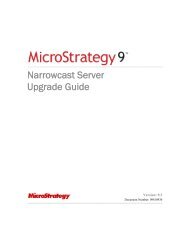MicroStrategy Mobile Design and Administration Guide
MicroStrategy Mobile Design and Administration Guide
MicroStrategy Mobile Design and Administration Guide
You also want an ePaper? Increase the reach of your titles
YUMPU automatically turns print PDFs into web optimized ePapers that Google loves.
1<br />
<strong>Design</strong>ing Reports <strong>and</strong> Documents for iOS <strong>and</strong> Android Devices <strong>Mobile</strong> <strong>Design</strong> <strong>and</strong> <strong>Administration</strong> <strong>Guide</strong><br />
7 Repeat the appropriate steps above to create each of the metrics required<br />
to calculate the distance to each store.<br />
8 Once you have created the distance calculation metric, Point_Distance,<br />
you can create any of the following prompts to use the metric:<br />
• A Metric Qualification prompt. You can add the prompt to a report to<br />
let users specify a distance radius for which to display data. For<br />
information on creating Metric Qualification prompts, see the<br />
<strong>MicroStrategy</strong> Web Help.<br />
• A Metric Set Qualification filter. You can add the filter to a report or to<br />
a dataset report in a document, to automatically filter the data using<br />
the current location of the mobile device.<br />
• A prompt or filter that will use the metric, added to a report displayed<br />
as a Map widget, or to the dataset report of a Map widget in a<br />
document. When the Map widget is displayed on a mobile device, only<br />
the map markers for locations within the specified distance from the<br />
mobile device are displayed.<br />
Metric Name Metric Definition<br />
Location_Lat Max(AttributeName@LatitudeFormName)<br />
Replace AttributeName with the name of the location<br />
attribute, <strong>and</strong> replace LatitudeFormName with the<br />
attribute form that contains the latitude information for each<br />
location. For example, for an attribute named Store with the<br />
attribute forms Latitude <strong>and</strong> Longitude, create a metric with the<br />
name Location_Lat, with the definition<br />
Max(Store@Latitude).<br />
Location_Long Max(AttributeName@LongitudeFormName)<br />
Replace AttributeName with the name of the location<br />
attribute, <strong>and</strong> replace LongitudeFormName with the<br />
attribute form that contains the longitude information for each<br />
location. For example, for an attribute named Store with the<br />
attribute forms Latitude <strong>and</strong> Longitude, create a metric with the<br />
name Location_Long, with the definition<br />
Max(Store@Longitude).<br />
DeltaLat/2 (Radians(([Location_Lat] -<br />
?LatitudePromptName)) / 2)<br />
Replace LatitudePromptName with the name of the<br />
value prompt for latitude. For example, if the value prompt is<br />
named Latitude, the definition is<br />
(Radians(([Location_Lat] - ?Latitude))<br />
/ 2).<br />
66 Displaying data as interactive visualizations: widgets © 2012 <strong>MicroStrategy</strong>, Inc.



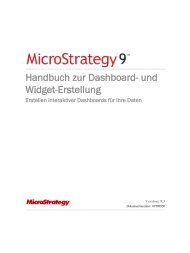
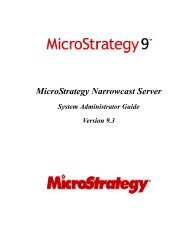
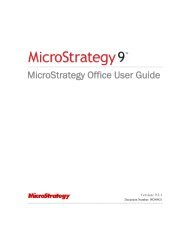




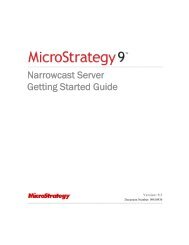

![The New Era of Mobile Intelligence: [PDF] - MicroStrategy](https://img.yumpu.com/13859921/1/190x245/the-new-era-of-mobile-intelligence-pdf-microstrategy.jpg?quality=85)
![customer success story [pdf] - MicroStrategy](https://img.yumpu.com/13859884/1/190x146/customer-success-story-pdf-microstrategy.jpg?quality=85)
![Call for Speakers Guide [PDF] - MicroStrategy](https://img.yumpu.com/13859856/1/190x245/call-for-speakers-guide-pdf-microstrategy.jpg?quality=85)
